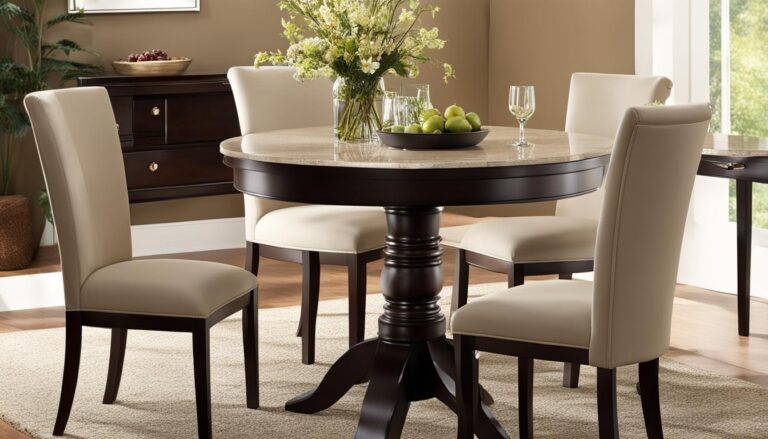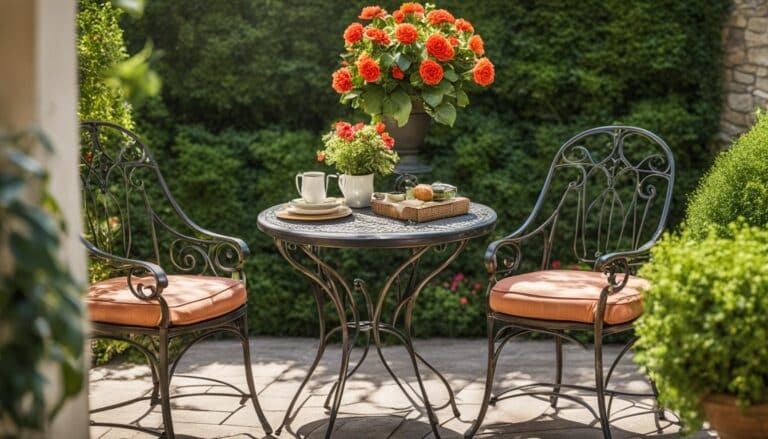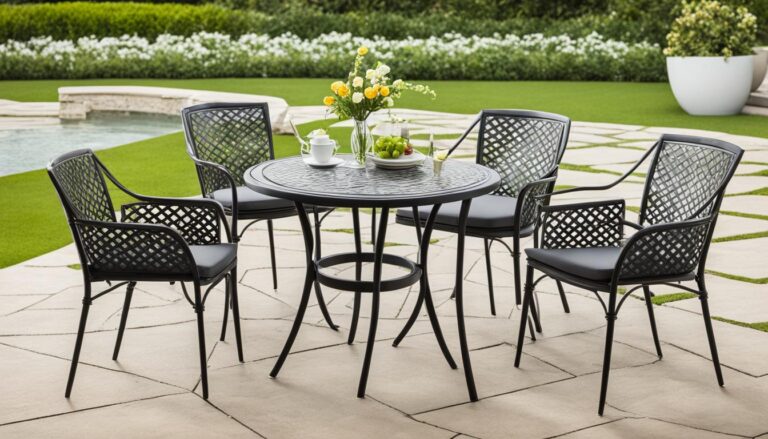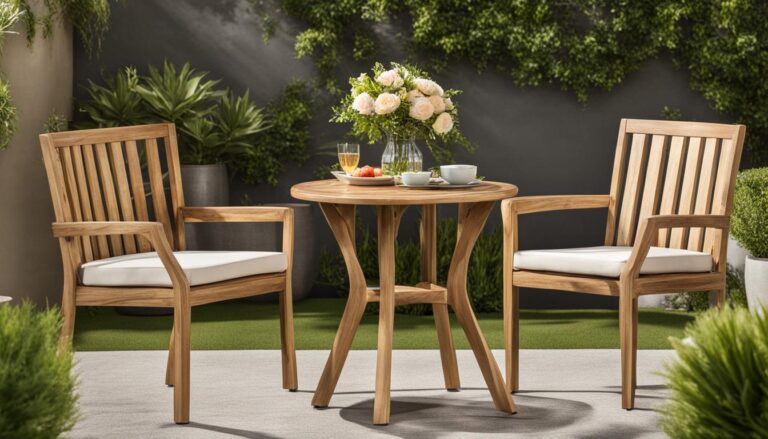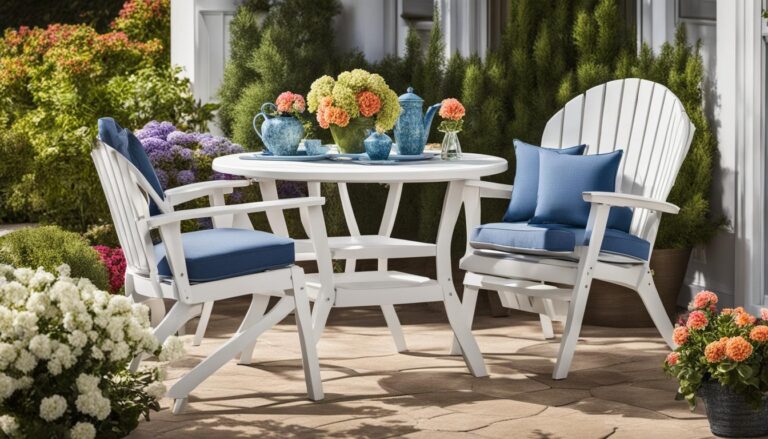Outdoor wood furniture can add beauty and warmth to your outdoor space while creating a comfortable environment for you and your loved ones to relax and unwind. However, exposure to the elements can take a toll on your furniture, causing it to fade, crack, or rot over time. That’s where proper sealing comes in to protect your investment for years to come.
In this section, we will guide you through the best techniques and tips on how to seal outdoor wood furniture. From understanding the importance of sealing to choosing the right sealant and applying it effectively, we will cover everything you need to know to ensure your furniture’s longevity and maintain its appearance.
Key Takeaways:
- Sealing outdoor wood furniture is crucial to protect it from the elements and extend its lifespan.
- Choosing the right sealant is important for optimal protection and longevity.
- Proper preparation, application, and maintenance are essential for successful outdoor furniture sealing.
Understanding the Importance of Sealing Outdoor Wood Furniture
Before you start sealing your outdoor wood furniture, it’s essential to understand why it’s an important step in its maintenance. Outdoor furniture is exposed to harsh weather conditions, UV rays, and moisture, making it vulnerable to damage. Sealing your furniture helps to create a protective barrier that prevents water, dirt, and other outdoor elements from penetrating the wood.
But sealing isn’t just about protection; it also helps to preserve the look of your furniture. Unsealed wood furniture can become faded, discolored, and prone to rot and decay. By sealing your furniture, you can maintain its natural color and texture, as well as prolong its lifespan.
To ensure that your outdoor wood furniture lasts as long as possible, it’s also vital to take good care of it. Wiping down your furniture regularly and covering it during harsh weather conditions can help to extend its life even further.
Choosing the Right Sealant for Outdoor Wood Furniture
When it comes to sealing your outdoor wood furniture, choosing the right sealant is crucial. Not all sealants are created equal, and the wrong choice could lead to ineffective protection or damage to your furniture. Here are some factors to consider when selecting the best sealant for your outdoor wood furniture:
| Type of Sealant | Pros | Cons |
|---|---|---|
| Oil-based sealant | Deep penetration, long-lasting, enhances natural wood color. | Takes longer to dry, emits fumes, requires solvent for cleanup. |
| Water-based sealant | Quick-drying, low odor, easy cleanup, UV resistant. | May raise the wood grain, can result in a cloudy finish. |
| Clear vs. tinted | Clear sealant allows the natural wood grain to show through. Tinted sealant offers added color and UV protection. | Tinted sealant may alter the wood’s appearance. The wrong shade can clash with your outdoor color scheme. |
Consider the climate and weather patterns in your area, the type of wood your furniture is made from, and the look you are trying to achieve. With so many options available, you’re sure to find a sealant that suits your needs and preferences.
Preparing Your Wood Furniture for Sealing
Proper preparation is crucial to ensure effective sealing of your outdoor wood furniture. Skipping any of the following essential steps may lead to poor adhesion and a short lifespan of the sealant. Here’s how to prepare your furniture for sealing:
- Clean your wood furniture: Start by removing any dirt, grime, or stains from the wood surface. Use a wood cleaner or a solution of mild soap and water, and scrub the furniture thoroughly with a soft-bristled brush. Rinse with clean water and let it dry completely for at least 24 hours.
- Sand the surface: Once the furniture is dry, use a fine-grit sandpaper to smooth out any rough spots, splinters, or imperfections. Sand in the direction of the wood grain, and make sure to remove any dust or debris using a tack cloth or a dry cloth.
- Remove old finishes: If your furniture has any old finishes or coatings, such as paint or varnish, you need to remove them before applying the sealant. You can use a paint stripper or a scraper to take off the old layer, following the manufacturer’s instructions and safety precautions.
- Repair any damage: Check your furniture for any cracks, chips, or splits, and repair them with wood filler or putty. Smooth out the surface with sandpaper and wipe clean with a damp cloth.
- Let it dry: Make sure your wood furniture is completely dry before proceeding to the next step. If necessary, let it sit in a well-ventilated area for a day or two to allow any remaining moisture to evaporate.
Following these steps will ensure that your wood furniture is ready to receive the sealant and that it will adhere properly, providing long-lasting protection against the elements.
Applying the Sealant to Your Outdoor Wood Furniture
Now that you have prepared your wood furniture for sealing, it’s time to apply the sealant. Follow these expert tips and techniques to ensure a successful sealing process:
- Choose the right brush: For best results, use a high-quality natural-bristle brush with long, flexible bristles. Avoid using foam brushes, as they can leave bubbles and streaks in the sealant.
- Apply in thin, even coats: Apply the sealant in thin, even coats, working with the grain of the wood. Start from the top and work your way down, using long strokes. Avoid overloading the brush with sealant, as this can lead to drips and uneven coverage.
- Allow sufficient drying time: After the first coat, allow the sealant to dry completely, following the manufacturer’s instructions. This usually takes 4-6 hours. Sand lightly with fine-grit sandpaper between coats to ensure a smooth finish.
- Apply multiple coats: Apply two or three coats of sealant, allowing sufficient drying time between each coat. This will ensure maximum protection and durability for your outdoor wood furniture.
- Protect from the elements: After sealing, protect your furniture from rain and harsh weather for at least 24 hours. Cover with a tarp or move indoors if necessary.
Expert tip: Don’t rush the sealing process! Take your time and ensure each coat is applied carefully and evenly. This will help you achieve a smooth, durable finish that will protect your furniture for years to come.
Drying and Curing Time for Sealed Wood Furniture
Once you have applied the sealant to your outdoor wood furniture, it’s essential to allow sufficient drying and curing time before using it. The exact time required varies depending on the type of sealant used and the weather conditions.
As a general rule of thumb, oil-based sealants typically require 24-48 hours to dry completely, while water-based ones need at least 3-4 hours. However, if the weather is hot and dry, the drying time may be shorter. On the other hand, if it’s cold and humid, the sealant may take longer to dry.
Once the sealant has dried, it’s essential to allow it to cure fully before using the furniture. Curing time refers to the period when the sealant becomes fully hardened and reaches its maximum durability. Oil-based sealants typically take 2-3 days to cure, while water-based ones may need up to a week.
To ensure the best results, avoid exposing your newly sealed furniture to water or heavy use during the drying and curing period. Also, keep in mind that the curing process may take longer in cooler and more humid climates.
Maintaining and Re-Sealing Outdoor Wood Furniture
Congratulations! Your outdoor wood furniture is now beautifully sealed and protected. However, to ensure its long-lasting beauty and durability, you need to follow proper maintenance and re-sealing practices. Here are some tips to help you keep your furniture in top condition:
Regular Cleaning
Regular cleaning is essential to prevent dirt buildup, which can damage the protective sealant and compromise the wood’s integrity. Use a mild soap solution and a soft-bristled brush to gently clean your furniture, then rinse thoroughly with water and dry with a clean towel. Avoid using harsh cleaning products or power washers, as they can strip the sealant and cause permanent damage.
Periodic Inspection
Inspect your furniture regularly for any signs of wear or damage, such as cracks, peeling, or discoloration. If you notice any issues, address them promptly to prevent further damage and ensure the best protection for your furniture.
Re-Sealing
Depending on the frequency of use and exposure to the elements, you may need to re-seal your outdoor wood furniture every 1-3 years. To do this, follow the same preparation and application steps as described earlier. Make sure to remove any old sealant and begin with a clean, dry surface. Apply a fresh coat of sealant in thin, even layers, and allow sufficient drying and curing time before using the furniture.
By following these maintenance and re-sealing tips, you can prolong the life of your outdoor wood furniture and enjoy it for many years to come.
Additional Tips for Outdoor Wood Furniture Care
While sealing and maintaining your outdoor wood furniture are essential for its longevity and appearance, there are other measures you can take to protect it from common issues. Here are some additional tips for outdoor furniture care:
- Avoid direct sunlight: Prolonged exposure to UV rays can cause fading, warping, and cracking of your wood furniture. Consider placing your furniture in shaded areas or using umbrellas or canopies to provide shade.
- Clean regularly: Remove dirt, debris, and bird droppings regularly to prevent buildup and staining. Use a soft-bristled brush and mild soap and water to clean your furniture. Avoid using harsh chemicals or abrasive materials that can damage the sealant or wood.
- Use furniture covers: If you plan to leave your outdoor furniture uncovered for an extended period, consider using waterproof covers to protect it from rain and snow. This can also prevent dirt and debris from accumulating on the furniture.
- Protect from moisture: Moisture can cause warping, swelling, and mold growth on your wood furniture. Use coasters and placemats to prevent water damage from glasses or hot dishes. Consider using furniture glides to elevate your furniture off damp ground or deck surfaces.
- Store indoors during winter: If possible, store your wood furniture indoors during the winter season to protect it from extreme temperature changes, moisture, and snow buildup. If storing indoors is not an option, cover your furniture with waterproof tarps or plastic sheets.
By following these additional tips and incorporating them into your outdoor furniture care routine, you can prolong the life of your furniture and make the most of your investment. Happy furniture maintaining!
Conclusion
Congratulations! By following the expert tips and techniques outlined in this article, you are well on your way to preserving and protecting your outdoor wood furniture. Remember, proper sealing is essential to ensure the longevity of your furniture and maintain its appearance.
By understanding the importance of outdoor furniture maintenance, choosing the right sealant, preparing your furniture correctly, applying the sealant properly, allowing for sufficient drying and curing time, and regularly maintaining and re-sealing your furniture, you can enjoy your outdoor wood furniture for years to come.
Keep Learning and Exploring
There are always new techniques and products to explore when it comes to caring for your outdoor wood furniture. Be sure to continue learning and researching to stay up-to-date on the latest trends and best practices.
Thank you for reading, and happy preserving!
FAQ
Q: How do I seal outdoor wood furniture?
A: Sealing outdoor wood furniture is a simple process. First, clean the furniture thoroughly and remove any old finishes. Then, apply the chosen sealant using a brush or roller, following the manufacturer’s instructions. Allow the sealant to dry and cure completely before using the furniture.
Q: Why is sealing outdoor wood furniture important?
A: Sealing outdoor wood furniture is crucial for its longevity and protection. Sealing helps to prevent moisture damage, UV fading, and other outdoor elements that can degrade the wood. It also enhances the appearance of the furniture and makes it easier to maintain.
Q: What is the best sealant for outdoor wood furniture?
A: The best sealant for outdoor wood furniture depends on your preferences and the specific needs of your furniture. Options include oil-based sealants, water-based sealants, and clear or tinted sealants. Consider factors such as durability, ease of application, and desired finish before making your choice.
Q: How should I prepare my wood furniture for sealing?
A: Proper preparation is essential for effective sealing. Start by cleaning the furniture thoroughly and sanding any rough areas. If the furniture has old finishes, remove them completely before applying the sealant. This ensures better adhesion and a longer-lasting seal.
Q: How do I apply the sealant to my outdoor wood furniture?
A: When applying the sealant, use a brush or roller, and follow the manufacturer’s instructions. Apply an even coat of sealant, working with the grain of the wood. Depending on the sealant type, you may need multiple coats for optimal protection. Allow each coat to dry before applying the next.
Q: How long does it take for the sealant to dry and cure?
A: The drying and curing time for sealed wood furniture can vary depending on the sealant type and environmental conditions. Generally, allow at least 24 hours for the sealant to dry completely before using the furniture. For optimal results, follow the recommendations provided by the manufacturer.
Q: How do I maintain and re-seal outdoor wood furniture?
A: Regular maintenance is important to keep your sealed wood furniture in good condition. Clean the furniture regularly and avoid using harsh cleaning products that can damage the sealant. Over time, if you notice signs of wear or if water no longer beads on the surface, it’s time to re-seal the furniture. Follow the same sealing process as before to refresh the protective layer.
Q: What are some additional tips for outdoor wood furniture care?
A: In addition to sealing and maintenance, consider using furniture covers when the furniture is not in use to protect it from the elements. Avoid placing hot items directly on the wood surface, as it can cause damage. If possible, bring the furniture indoors during extreme weather conditions. These measures will help prolong the life of your outdoor wood furniture.


